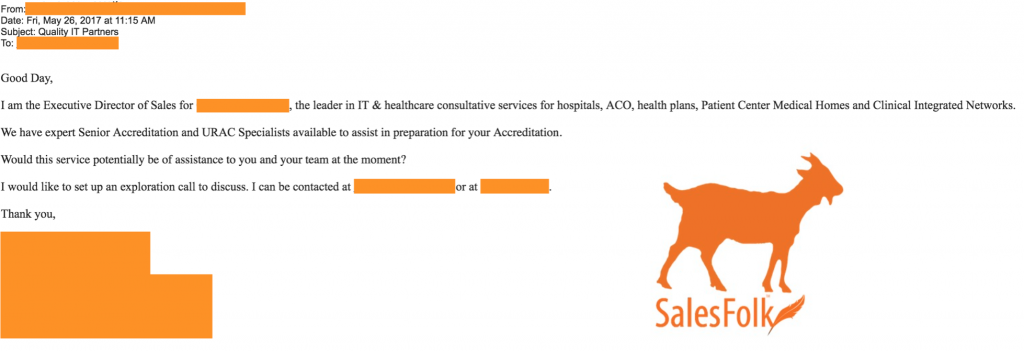Most of us know shameless self-promotion in a cold email makes the sender look like an egomaniac who isn’t interested in getting to know their prospects. But sometimes, self-focused copy isn’t offending potential customers. It’s just making the emails utterly boring and incredibly forgettable. Watching paint dry is more exciting than reading a cold email where the sender keeps the focus completely on themselves.
Case in point, our latest Hall of Shame candidate:
Let’s start from the top to see how this email not only fails to capture our attention, but focuses so much on the sender’s perspective it’s impossible to relate to the email and feel compelled to respond.
- Poor targeting
First, it’s clear the sender bought a poorly targeted list, since the recipient of this email doesn’t work in healthcare and never has. The priority here seems to be emailing as many people as possible instead of stopping to think which companies and individuals are a good match for the business. Prospects will take this to mean you don’t really care about their needs.
The fix: Researching your ideal targets and investing in a quality list is the first step to ensure your words won’t fall on disinterested eyeballs. - Vague, selfish subject line
“Quality IT Partners,” is so vague it would be easy to skip over in the inbox. It tells us nothing about the sender’s business or how it might help the recipient. In fact, it looks as if the sender tacked a subject line on last minute, without much thought. That level of laziness becomes self indulgent in the sense that it assumes the reader will open the email no matter what.
The fix: A subject line like “{!Company}’s path to URAC accreditation” or “{!First}, is URAC accreditation on your mind?” is much more specific, and therefore does a better job of taking the recipient’s needs into account. - Self centered from the start
The first word of this email, “I,” tells you everything you need to know about the sender’s passion for focusing on who they are instead of what their prospect needs. The remaining lines follow suite: “We have,” “Would this service,” and “I would like.” The email is a story about the sender, not the recipient, and cold emails that are about anyone other than the recipient usually fall flat.
The fix: Change “I” to “you” and adjust sentences to fit the second-person point of view. - Bloated, meaningless credentials
Words like “leader” and “expert” are undescriptive and meaningless without supporting evidence. Most often, a prospect will take those words to be bragging and move on without a response.
The fix: Instead of a bland label like “leader,” the sender could opt for a descriptor that says, “recently featured in the Gartner Magic Quadrant for X” or “named the top IT accreditation company in 2017.” - No social proof or mention of success
Finally, the email falls short in the one place that it’s okay to be a little self-indulgent: the social proof. The body of the email tells you what the sender offers (accreditation experts), but gives no reason why the recipient should chose them over another company. In this case, a little bit of social proof or a statistic can go a long way.
The fix: Dropping in the number of accreditations they’ve successfully obtained and the companies they’ve obtained them for plus a few other metrics of industry success (possibly mean time to accreditation?) adds significant value.
Have bad cold emails in your inbox? Send them to us!
Help us fight the thoughtless spammers, one crappy cold email at a time by sending us the worst cold emails you’ve ever received. We’ll put them up anonymously on the “Hall of Shame,” and shoot you an email when they go live.
Please send all submissions to “[email protected].” (And feel free to suggest what you want to nominate the bad cold email for!)


